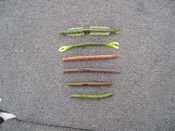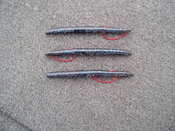 Stickworms could be argued as the best worm ever produced. I don’t think anyone can dispute the simplicity and effectiveness of the bait. Whether you use Senkos, Salty Slings, Wave Worms or whatever brand, they are all very simple baits that can produce both quality and numbers of bass.
Stickworms could be argued as the best worm ever produced. I don’t think anyone can dispute the simplicity and effectiveness of the bait. Whether you use Senkos, Salty Slings, Wave Worms or whatever brand, they are all very simple baits that can produce both quality and numbers of bass.
First let’s take a look at a stick worm. There is really nothing to it. It just looks like a rubber stick. You might ask “What is so great about that bait?” The old saying “Never judge a book by its cover” really applies to this bait. No, there are no appendages or a tail, but looks can be deceiving. This bait really comes to life when you toss it in the water. While slowly sinking it produces this mesmerizing wiggle that bass can’t resist. The majority of the strikes will come on the fall. The only skill required to fish this bait is to be patient enough to let it sink.
 For such a simple bait there are many ways to rig it. Most people prefer to rig it weightless. They let the weight of the worm and the hook do all the work. This is my preferred method. I’ve been known to let the bait sink to the bottom in 20 foot of water. It takes time and you have to be patient, but it often pays off. The two main ways to rig the bait are the Wacky Rig and a weightless Texas Rig.
For such a simple bait there are many ways to rig it. Most people prefer to rig it weightless. They let the weight of the worm and the hook do all the work. This is my preferred method. I’ve been known to let the bait sink to the bottom in 20 foot of water. It takes time and you have to be patient, but it often pays off. The two main ways to rig the bait are the Wacky Rig and a weightless Texas Rig.
First let’s look at the Wacky Rig. The Wacky Rig simply means hooking the worm at the midpoint of the worm. This rig keeps the worm equally balanced. For the most part it will sink straight down. It also provided a pivot point when you move the worm. There are a number of ways to Wacky Rig it. I like a circle hook right in the middle. The circle hook has a smaller and is safer for the fish. The nice thing with the circle hook is if the fish swallows the bait the hook generally comes out with minimal to no damage to the fish yet it will still catch them in the corner of the mouth. When you need a weedless application you can hook it the same way with a weedless hook or Texas Rig it in the middle of the worm. I’ve had the best luck with it rigged Texas Style in the middle. It is a little tougher to rig up. Make sure you wet the hook so it slides through the worm without tearing it up. What I do is start in the middle of the worm and bury the hook about halfway through the bait. After about a ¼” I’ll guide the hook back out. Now you’ll want to pull the rest of the hook through the bait and carefully twist the hook as you come to the offset. If the bait tears it is often at this point. Now that the hook has been pulled through simply hide the hook in the worm as you normally would with a Texas Rig. This is weedless and provides a pivot point of the worm. Fishing the Wacky Rig is simple. Toss it out there and let it sink. The memorizing wiggle it produces will do all the work. All you have to do is watch your line. Often when you get a strike the line will hop or take off. If it sinks to the bottom lift your rod tip a couple feet to lift the bait back up and let it sink again. When you lift the worm up with a Wacky Rig it kind of resembles a fleeing crawfish. The worm will fold in half and each end may look like the claws tailing behind the bait.
Now the Weightless Texas Rig is pretty simple. Take your hook and insert it straight into the head of the worm about ¼ to ½ and inch. Then guide the hook back out. Pull the hook through the worm twist it around as you come to the offset of the hook. Then hide the barb of the hook back into the worm. This rig is totally weedless and can be thrown around all types of cover. Often times it doesn’t sink straight. With the majority of the weigh at the head of the worm it will tend to glide and wiggle in the direction of the head. Here’s a tip if you are fishing weed lines. Turn the worm around and hook it through the tail. Remember the old Flying Lures? This does kind of the same thing. The bulk of the weight is still at the head of the worm, therefore it will want to sink away from you. What I like about this is it dives into the weeds where the fish are. Just like the Wacky Rig when is sinks to the bottom without a strike lift the rod tip. The worm will dart up from the bottom and slowly sink back down. Another method of retrieve I’ve found works well with smallmouth bass is if they don’t bite on the initial fall I will work the worm back just like a jerkbait. I will give it a couple jerks and let it pause a second or two and then I’ll give it another jerk or two. I do this all the way back to the boat. Sometimes the smallies prefer a little more action to get them in the mood to bite
When ever fishing stick worms I try to maximize the use I can get out of a worm. I will always Texas Rig the bait at both ends as well as in the middle. When I wear one part of the worm out I will move to another. Sometimes I will bite ½” off the end of the worm to get a fresh place to hook into. This doesn’t happen very often as these worms tend to fall off the hook while fighting the bass. Another tip would be to use a split ring, a thin slice of rubber tubing or a thin slice of electrical shrink rap and slide it to the center of the worm. Then when you Wacky Rig it you can use any of those to hold the hook in place. This keeps from tearing your worm up or possibly losing it while battling a bass. Another tip would be weighting the worm. When wind conditions call for it you can insert a small nail or lead weight to one or both ends of the worm. This will help the worm sink a little better when the wind is blowing you line.
While there are many brands of stick worm there are a few that I really like. The Senko is one of the best. The problem with them is they are really soft and tear up easily. What I like about them is they absorb water. This does two things. They sink a little faster when a fish clamps down on them the juices come out. Heavily salted baits do the same thing. Baits like the Venom Salty Sling will absorb water as the salt dissolves. They will sink faster after some use and when the bass chomps down on them the salty juices will come out. The added bonus with Venom is the baits are a little more durable. There are other stick worms out there that aren’t laced with salt or as soft. Yes, these baits might be more durable but those stiffer worms also don’t produce as much action. So you have to weigh your options and buy what works best for you.
When it comes to rod and reel combos it is pretty simple. You can use spinning gear if you’d like or stick worms cast well with a bait casting combo as well. As with any worm rod you will want something with plenty of back bone for a solid hook set, but if you are fishing lighter tackle simply use lighter wired hooks. They penetrate with a lot less effort. I find the line to be the most important part. I like to use fluorocarbon. The properties of the line make it more sensitive when it comes to feeling the bites and it also sinks with the bait. I feel that a floating line like monofilament or braid will slow the rate of fall and kill some of the action of the worm.
As you can see this simplistic little bait has many options for rigging. I’m sure there are many other ways to fish these baits. I think the Wacky Rig is the best method for fishing these worms for most situations, and there is no wrong method to rig them. I just thought I’d share my most productive methods of fishing these baits. If you haven’t tried them yet, pick yourself up a bag of stickworms and try them out for yourself. Trust me, you will be glad you did.
I’ve really narrowed down my color selection on all of my baits. 99% of the time I either have black w/blue flake or green pumpkin. I don’t let the worm sit that long if it makes it to the bottom. I feel that the action on the fall is what draw most of the strikes. So if it hits the bottom I draw it back up a couple feet to let it fall again. I haven’t tried a rattle on one yet. It is a good idea. I’m not sure it would make much noise on the fall, but when you move the worm I’m sure it would make some noise. As far as slugos, I’ve never used one. There are many ways to fish stick worms. This article focuses on weightless strategies. I’ve rigged them on jig heads, Carolina rig, drop shot and weighted Texas rig.
Another secret that has worked for me. I rigged up a drop shot and wacky rigged the bait. In addition to that I had a slip bobber on the line. I use this to caught suspending bass and bass suspending in standing timber. With the slip bobber I can control how far the worm can sink. I try to set the bobber so the worm will suspend just above the fish. Once the worm has sunk to the depth I set it to often times the wave action on the surface causes the worm to really wiggle around just above the bass. I can also lift the worm and let it fall again and again in one cast. At times it works pretty good and the slip bobber also aides in casting.
Jason
thanks Jason for a great read. looking forward to messing around with some of this stuff. I do most of it already, but there are a few things that I haven’t thought of yet.
shane